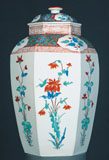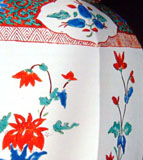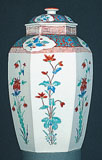- Museum Accession No.: EA1978.688
- Catalogue No.: 269
- Object type: Jar and cover
- Kiln/Location: Kakiemon style, Arita
- Period/Date: c. 1680
- Dimensions: H. 31.0 cm, D. 19.0 cm
- Provenance: Reitlinger gift
- Description: Hexagonal jar and cover. So-called Hampton Court vase; high shoulder, fitted hexagonal cover with flattened knob. Panelled sides. Flat biscuit base. Red, blue, green and brown enamels in variation of Kakiemon palette. On panelled sides, two different flowering plants, each repeated twice. On shoulder, narrow border of red flag decoration and wide border of green scrolling on red background. On three corners, blue flowers with lobed cartouches. The shoulder decoration repeated on the lid.
The reason that the 'Hampton Court' vases are separated from the Kakiemon is the presence of brown enamel in the decoration; this colour enamel appears only to be present on this shape and on a particular type of square jar; see, e.g., text fig. 5 and Porcelain for Palaces, 1990, pls. 148, 149. Had the Kakiemon had the use of brown enamel, it is inconceivable that it should not appear commonly elsewhere. The name 'Hampton Court vase' derives from the conjecture by Arthur Lane (1950) that certain Chinese and Japanese porcelains still in the Royal ollection and preserved at Hampton Court may derive from the collection of Queen Mary in the late 17th century. There is mention in the inventories of Kensington Palace of 1697 and 1699 (see Th. L. Scheurleer, 1962) of one coloured jarr & over of six squares' and several similar entries, which Lane, probably correctly, associated with the present shape. Queen Mary's porcelain at Kensington was given to the Duke of Albemarle after her death in 1694 and taken to Holland in 1699 (Shulsky, 1990), though the porcelain at Hampton Court may have remained there. See also Hinton and Impey (1998). There are two shape variations of this vase, as well as versions in blue-and-white. There is a taller and slightly straighter version, which also bears a palette of softer colours than here (see Porcelain for Palaces, 1990, pl. 153, and a pair in the Bowes Museum, Barnard Castle); this taller version does not bear brown enamel (see above). The blue-and-white versions are also in this taller shape, see no. 104 and Porcelain for Palaces, 1990, pl. 154. For an example of this, the shorter version, in the British Museum, see Porcelain for Palaces, 1990, pl. 155; as here, this has two alternating patterns of plant motifs on the sides. For a version with two more robust plant motifs and a more open shoulder pattern, in Dresden, inventoried in 1721, see Reichel, 1981, pl. 33. A closely related version has plants alternating with plants on which sits a long-tailed bird (see Sekai toji zenshu, 8, 1978, no. 37; Kyushu Ceramic Museum, 1999, pl. 30; Kassel, 1990, no. 212). A fourth variation is markedly different: there are three different painted motifs, each of which occupies two sides of the vase and the three pictures are divided by lines of blue and green leaves, see Porcelain for Palaces, 1990, no. 151. This shape was much imitated elsewhere and numerous pastiches of the shape were produced in many European ceramic factories. For a pair of Red Anchor Chelsea vases in the Royal Collection, see Porcelain for Palaces, 1990, pl. 152, where they are incorrectly identified as Japanese. For the second type of floral decoration on a Meissen example in the British Museum, see Porcelain for Palaces, 1990, pl. 195; and for a Chelsea example of the type with the bird, see Porcelain for Palaces, 1990, pl. 196. For a Meissen example of the shape decorated with chinoiseries after J. G. Horoldt, see Porcelain for Palaces, 1990, pl. 197. For Chelsea and Worcester pastiches, see Porcelain for Palaces, 1990, pls. 199-201.
- Exhibited: OCS, 1956, no. 91 (not illustrated)
- Similar Example:
- Illustrated:
|
Main View
|





